
Fengxiang woodblock New Year pictures have the artistic characteristics of rough and exaggerated figures and bright and bright colors. Among them, there is a type of New Year pictures commonly known as "Guyu paintings". It is derived from the folk belief of the Guyu solar term in Guanzhong. Other New Year pictures have different characteristics. In addition, Fengxiang's Guyu paintings are not only used for posters in this province, but also exported to nearby Gansu, Shanxi and other places with similar customs and habits as the Guanzhong area. category.
Grain Rain Solar Terms and the Spread of Grain Rain Paintings
Grain Rain, which means "rain gives birth to a hundred grains", is the sixth solar term of the twenty-four solar terms. Grain rain is usually the late spring season in the third month of the lunar calendar. At this time, the cold weather basically ends, the temperature rises rapidly, the accompanying precipitation gradually increases, and the air humidity increases, which is especially suitable for the growth of cereal crops. There is a set: "Grain rain, the grain is born from the rain." From the beginning of the grain rain, animals such as snakes, scorpions, mosquitoes and other animals also entered the growth and reproduction period, began to move frequently, and spread the plague.
In all parts of my country, there are many customs of the Grain Rain solar term, such as drinking Grain Rain tea, offering sacrifices to the sea in Grain Rain, "walking the Grain Rain" to strengthen the body, and eating toon in the Grain Rain. In the Guanzhong area in the central part of Shaanxi Province, during the Grain Rain, the local custom of offering sacrifices to Wenzu Cangjie and posting pictures of the Grain Rain is popular. "Huainanzi: Ben Jingxun" records: "In the past, Cangjie wrote books, but the sky rained grains, and the ghosts cried at night." Baishui, Luonan and other places in Shaanxi are places where Cangjie, the ancestor of Wenzu, was active. There are Cangjie Temples there. From the Spring and Autumn Period to the present, the activities of offering sacrifices to Cangjie during the Grain Rain are still preserved, accompanied by folk art forms such as folk noodle flowers, folk music, folk opera, and Shehuo.

Chicken eats five poisons Shaanxi Fengxiang Tai Liping
The Grain Rain painting in Fengxiang, Shaanxi Province is a kind of New Year picture that is unique to the local area and is posted before and after the Grain Rain. The content of such New Year pictures is mostly about the removal of the five poisons by the heavenly master, the five poisons eaten by chickens, the divine judgment of the house, and the boy who plays the piano to reduce poison, etc. Some New Year pictures are also accompanied by such as "In the third month of the Grain Rain, snakes and scorpions will never be born, too. Shang Laojun is like a decree" "In the third and a half months of Gu Yu, the scorpion will come to the case; pick up the kitchen knife and cut off the waist of the scorpion" and other words and incantations. This is because the temperature rises after the Grain Rain, and the pests and diseases enter a period of high reproduction. In order to reduce the damage to crops and people caused by the pests and diseases, the local people put up Grain Rain stickers to drive away evil spirits and entrust people to investigate and kill insects and hope for a good harvest and peace. The exact origin of Guyu painting is still unknown, but according to the late Shaanxi Fengxiang woodblock New Year's picture successor Tai Yi wrote: "Guyu painting was circulated in the world at the end of the Qing Dynasty, and it was quite popular in Shaanxi Guanzhong from the end of the Qing Dynasty to the beginning of the Republic of China. From the outbreak of the Anti-Japanese War to the founding of the People's Republic of China, it gradually declined. After liberation, few people produced it, and there was no custom to post it in the countryside. After the 'Gang of Four' was smashed, with the restoration of Fengxiang woodblock New Year pictures, some producers also regarded it as a New Year picture when producing New Year pictures. The production of New Year pictures will be put on the market before the Spring Festival and sold as New Year pictures." From this passage, we can see that at least in the late Qing Dynasty, Gu Yu pictures had become popular in the Guanzhong area of Shaanxi Province, and people classified them as New Year pictures. New Year picture workshop to complete the production, production and sales. In addition, according to Mr. Tai Yi's other articles, during the late Qing Dynasty and the early Republic of China, just before and after the Revolution of 1911, the thought was active, which led to some innovations in the content of the local New Year pictures in Fengxiang. At this time, the folk painters in Fengxiang not only created a new year painting tradition based on their own. The content of the criticism of Guyu paintings also incorporates the style and characteristics of New Year paintings in Hebei and other places in the form of New Year paintings, thus enriching and developing local Guyu paintings, with an annual output of hundreds of thousands or even millions of paintings, except in Baoji and Xi'an. , Xianyang, Weinan and other places sold, but also spread to Tongchuan and even the adjacent eastern Gansu, southern Shanxi and other places. In the 1980s, with the reform and opening up and the changes in people's production and lifestyle, the production and sales of Guyu Paintings gradually shrank. In Fengxiang, only three New Year painting workshops produced the annual production and sales volume of less than 30,000 pieces, and the sales methods were backward. Most of them are sold in markets and villages after the Spring Festival. Since the 1990s, due to the impact of the low price and rapid production of machine offset printing New Year pictures, coupled with the decline of folk customs and solar term culture in urban and rural areas in my country, similar to other types of folk New Year pictures, the production and market of Gu Yu pictures are even more sluggish, only the representative of Fengxiang New Year pictures. The Tai Liping family, a sex descendant, is producing, and most of the content is for blessings and auspiciousness, while the content of exorcising evil spirits is constantly decreasing or even discontinued.There are almost no restrictions on how and where Fengxiang Guyu paintings can be pasted. Doors, window sashes, kilns (small niches dug out of the walls for storing and placing scraps such as needles, threads, etc.), walls, and kang heads of Guanzhong dwellings are generally Gu Yu paintings can be posted. People paste and use this kind of Grain Rain painting during the Grain Rain season, which can not only pray for blessings and disasters, but also decorate the room and beautify the environment. Historically, Gu Yu paintings were produced in the same way as ordinary New Year paintings. The patterns were engraved on woodblocks and printed on yellow paper or plain paper. This production method also shows that the local circulation and demand of Gu Yu paintings are huge.
The Image Form of Gu Yu's Paintings
Since its birth, Guyu Painting has been developing and evolving in terms of subject matter and content, and has gradually broken through its content and form of eliminating the five poisons and spells, and has expanded to the worldly life, seasons, seasons, allegorical exhortations, landscapes and so on that are related to people's daily life , forming a rich image form, including secular figures, animals, gods and other image types. Among them, "Men's Ten Busy", "Women's Ten Busy" and "Twenty-Four Solar Terms", which reflect farming, production, life and solar terms, and "Mother and Sun Xi", "Grandpa Sun Le", and "Little Man", which reflect secular life, reflect the drive away from the five poisons. The "Chicken Eats the Five Poisons" and "Zhang Tianshi's Conquering the Five Poisons" are the most representative of the "Zhen Zhai Divine Judgment" and "Lingbao Divine Judgment", which reflect the town house to ward off evil spirits.

Male Ten Busy-1 Shaanxi Fengxiang Tai Liping
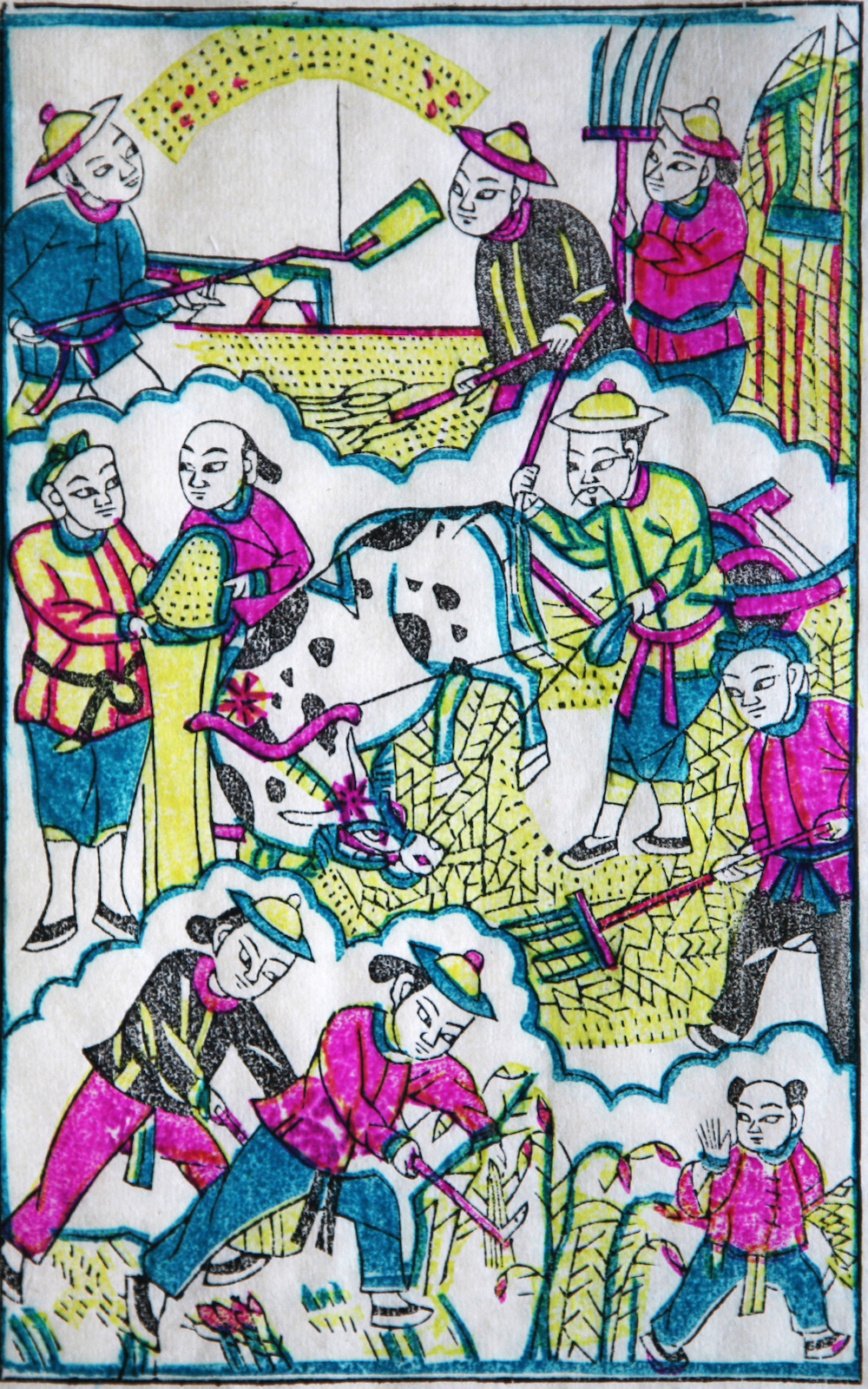
Ten Busy Men-2 Shaanxi Fengxiang Tai Liping
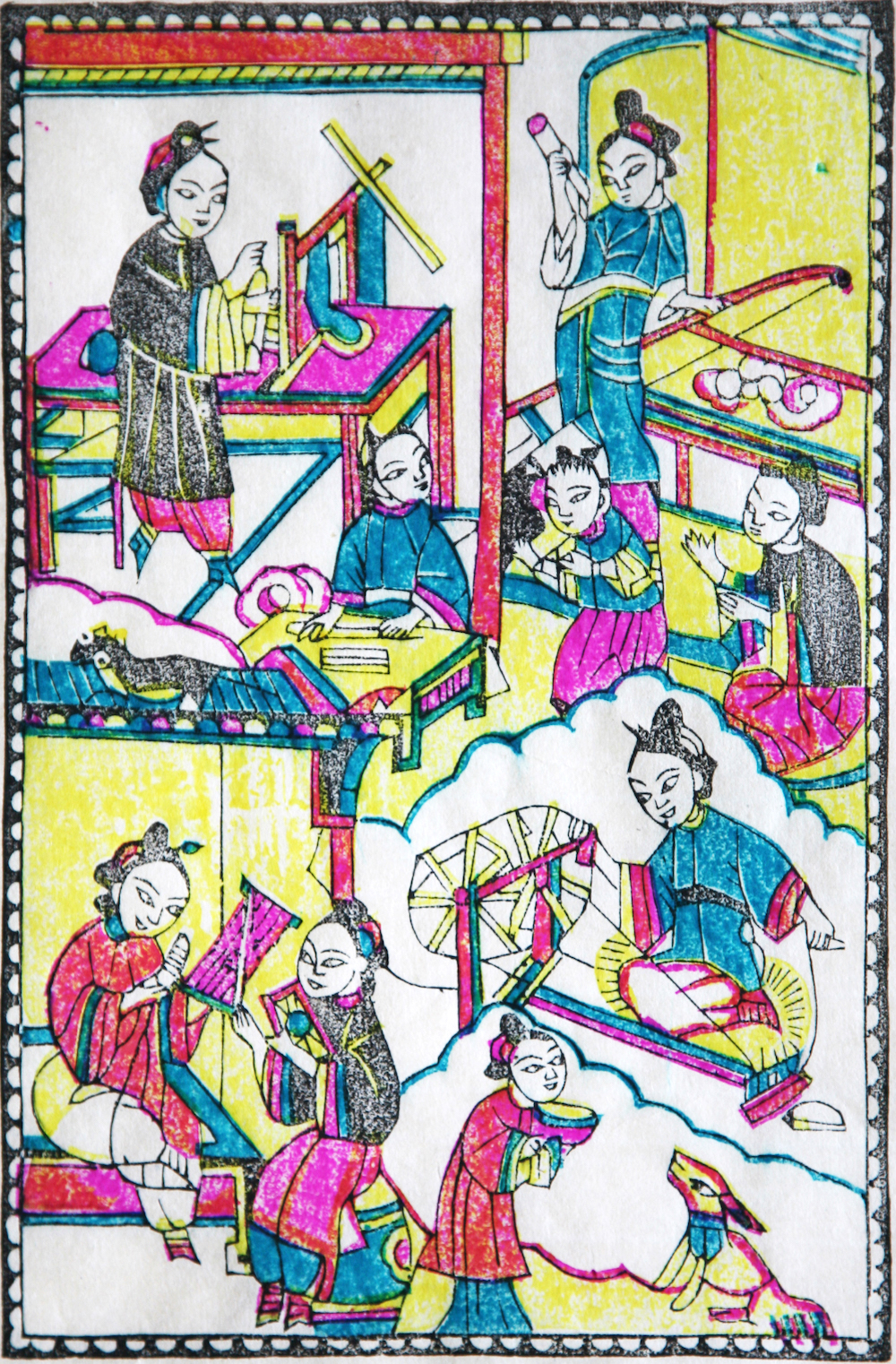
Female Ten Busy-1 Shaanxi Fengxiang Tai Liping

Female Ten Busy-2 Shaanxi Fengxiang Tai Liping
Qinchuan, 800 li in Guanzhong, Shaanxi, has been an agriculturally developed area since ancient times. It is known as the "Land of Abundance". People attach great importance to farming. There is also a folk saying in Guanzhong, "Before and after the Grain Rain, plant melons and beans." Farmers, so Fengxiang Guyu's paintings have a lot of content that reflects the hardworking and simple life of the working people, such as "Men's Ten Busy", "Women's Ten Busy", and "Textile Picture". The female weaving is the main picture. There are many people in each picture. The picture is full and rich, and the layout is reasonable, which is in line with the folk psychology of seeking roundness and fulfillment. Among them, "Ten Busy Men" is a New Year's picture with the theme of farming. The two paintings depict labor scenes such as ploughing, columbine, hoeing, harvesting, and grinding. The painting style is simple and full of life. In addition, there are also interesting pastoral scenes such as children delivering meals and eating in the fields. This "busy" person says that he is diligent and not lazy. He works at sunrise and rests at sunset. This is the case for generations, and he enjoys himself. There are seven to ten figures on each picture. Using the traditional flat composition, the figures are distributed in the picture naturally, balanced and full of changes. The content of the picture comes from labor production, which is real and vivid. The corresponding "Women's Ten Busy" and "Textile Maps" depict the scenes and the whole process of ancient hand-woven fabrics such as women's playing, twisting, spinning, threading, sizing, warp, and weaving. Busy" picture depicts children, dogs and other images, rendering a lively and joyful atmosphere. The small picture contains the manual work process like an assembly line, and the levels are clear and there is no congestion, reflecting the self-sufficiency. In the dominant feudal society, the living conditions of individual producers also reflected the labor scenes of men plowing and women weaving under the domination of the small-scale peasant economy, and it was a true portrayal of the lives of the people in our traditional society.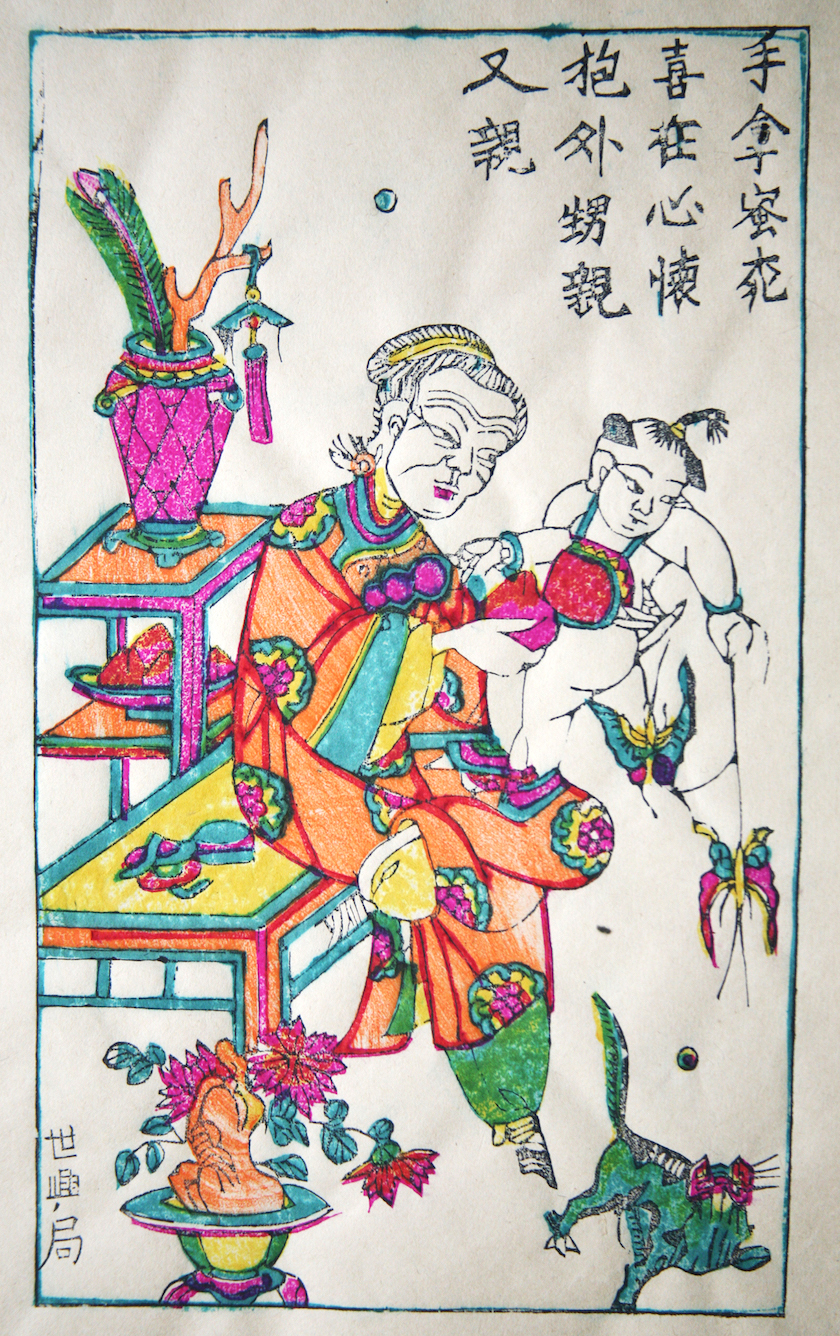
Grandma Sun Xi, Shaanxi Fengxiang, Tai Liping
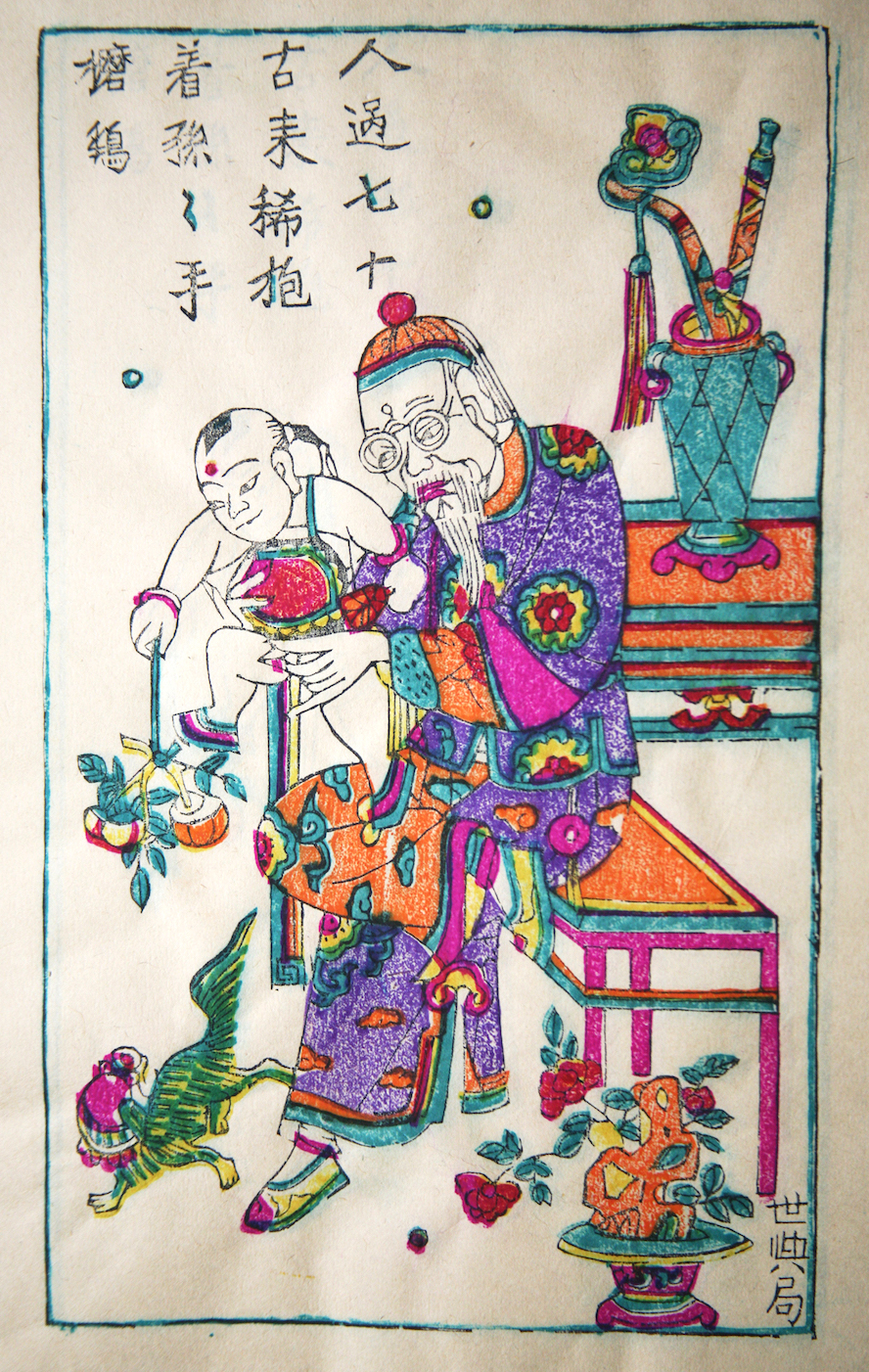
Grandpa Sun Le Shaanxi Fengxiang Tai Liping
The New Year pictures of "Grandfather Sun Xi" and "Grandpa Sun Le" are used to express the simple desire of people in traditional civil society to live a prosperous and happy life. These works are detailed and rigorous in depiction, the characters are full of life, and the composition is ingenious and compact, vivid and touching. These two New Year pictures take grandparents and grandchildren as the main objects, showing the joyful and cordial scenes of grandfather loving grandson and grandfather loving grandson, and reflecting the happiness of family members in the civil society after enjoying the harvest. The old man in the picture wears glasses and a short coat, and the old woman wears headbands and small feet. Both of them are dressed in gorgeous clothes. In addition, there are pets at home. It can be seen that the society was stable, the people were prosperous, and the happy life during this period. Scenes.
Figure-1 Shaanxi Fengxiang by Tai Liping
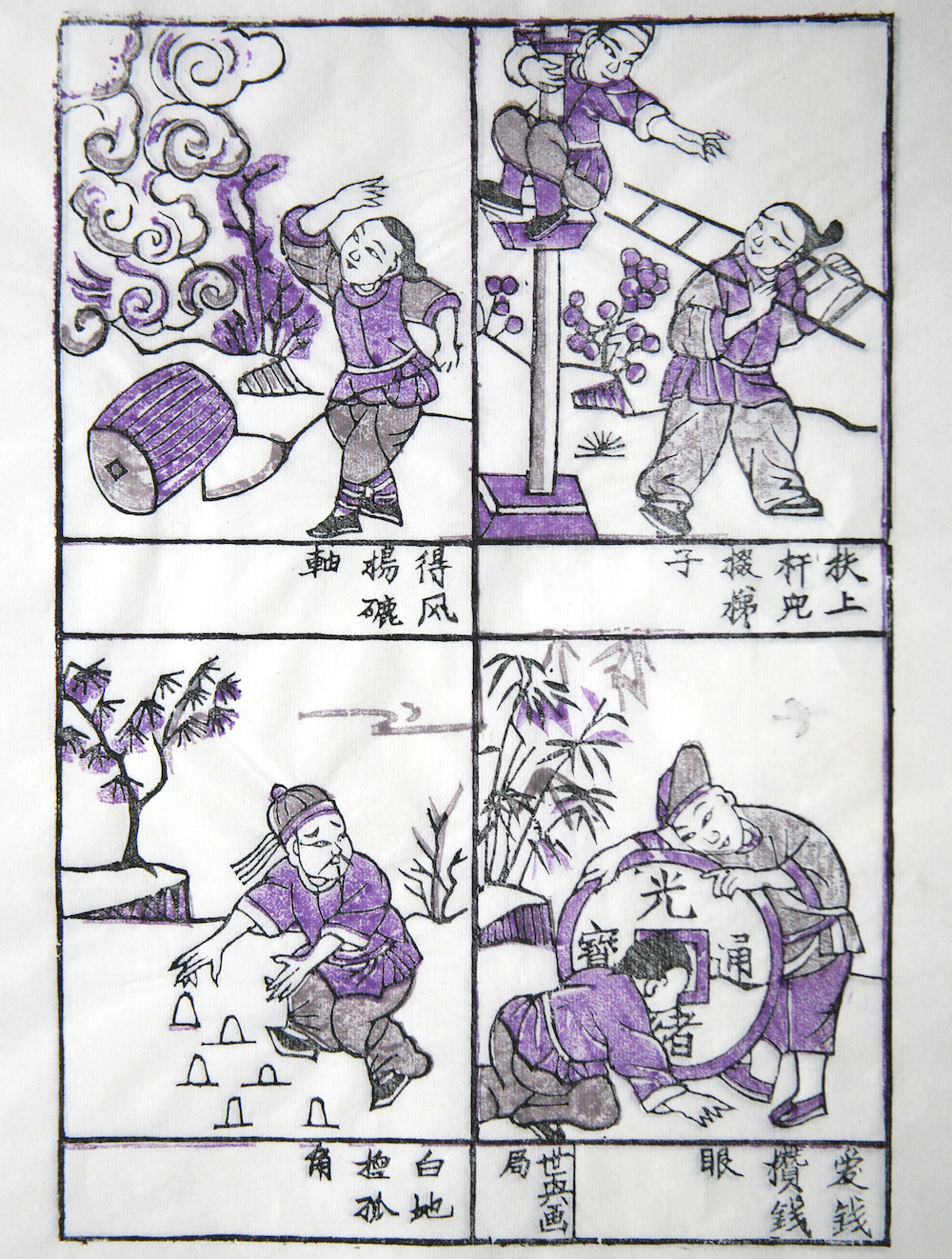
Figure-2 Shaanxi Fengxiang by Tai Liping
Although "Little Man" and "Fighting Mother-in-law and Turning into a Donkey" also show secular characters, their content is similar to a cartoon satirizing the society at that time, which has a certain significance of good teaching. For example, "Little Man" uses the form of "arguments" to ridicule the bad style of people who behave badly, which reflects people's dissatisfaction with the hypocritical behavior. In the picture, "Holding on the pole and holding the ladder" is a satire to lift people to the sky and then tear them down. "Pinching a lonely horn on the white ground" is a metaphor for creating something out of nothing; "Blowing up and pinching it away" is a fable and changeable; It is said that the east neighbor gave me the beauty of the sheep's head, and both sides were afraid of the poor gift, so they competed to offer its head, and the other person took advantage of both; It is even more ironic to welcome the ugly attitude of flattering and following the trend, and all of these are dismissed as villains (people with despicable behavior), so they are called "villain pictures". Such paintings can be the origin of Chinese comics. " Beating Mother-in-law and Turning into a Donkey" is also one of Fengxiang's New Year's paintings. It teaches daughter-in-law to be filial to her mother-in-law, otherwise the ancestors of Dongbin in the sky will turn her into a black donkey. Too unvirtuous, who would have known that there was a blue sky on his head, and the ancestors of Dongbin did not look down on him, and turned into a black donkey and the world turned around." This is one of the allusions circulated among the people. The pictures are colorful and the text is humorous and interesting to read without losing educational significance. In addition, the "Twelve Zodiac Signs" circulated among the folks, the picture is divided into six grids, with the inscription "Rats and sheep are incompatible, snakes see tigers and weep, pigs and monkeys are not in harmony, chickens and dogs cry, rabbits and dragons have grudges, white horses are afraid of green cattle. " and other words, and accompanied by the image of the picture to illustrate, this is a reflection of the Ming and Qing folk concept of mutual restraint. In ancient times, people used to refer to this text for marriage and spouses, but like many New Year pictures, although this New Year picture played a role in a certain period of time, it was superstitious and is no longer believed by people.Of course, the core function of Grain Rain Painting is to remind the general public to pay attention to preventing pests and pests in the season of rising temperature. Therefore, "Zhang Tianshi's Five Poisons", "Chicken Eats Five Poisons", and "Lei Gong's Five Poisons" have become the most posted in the Grain Rain season. A kind of Guyu painting.
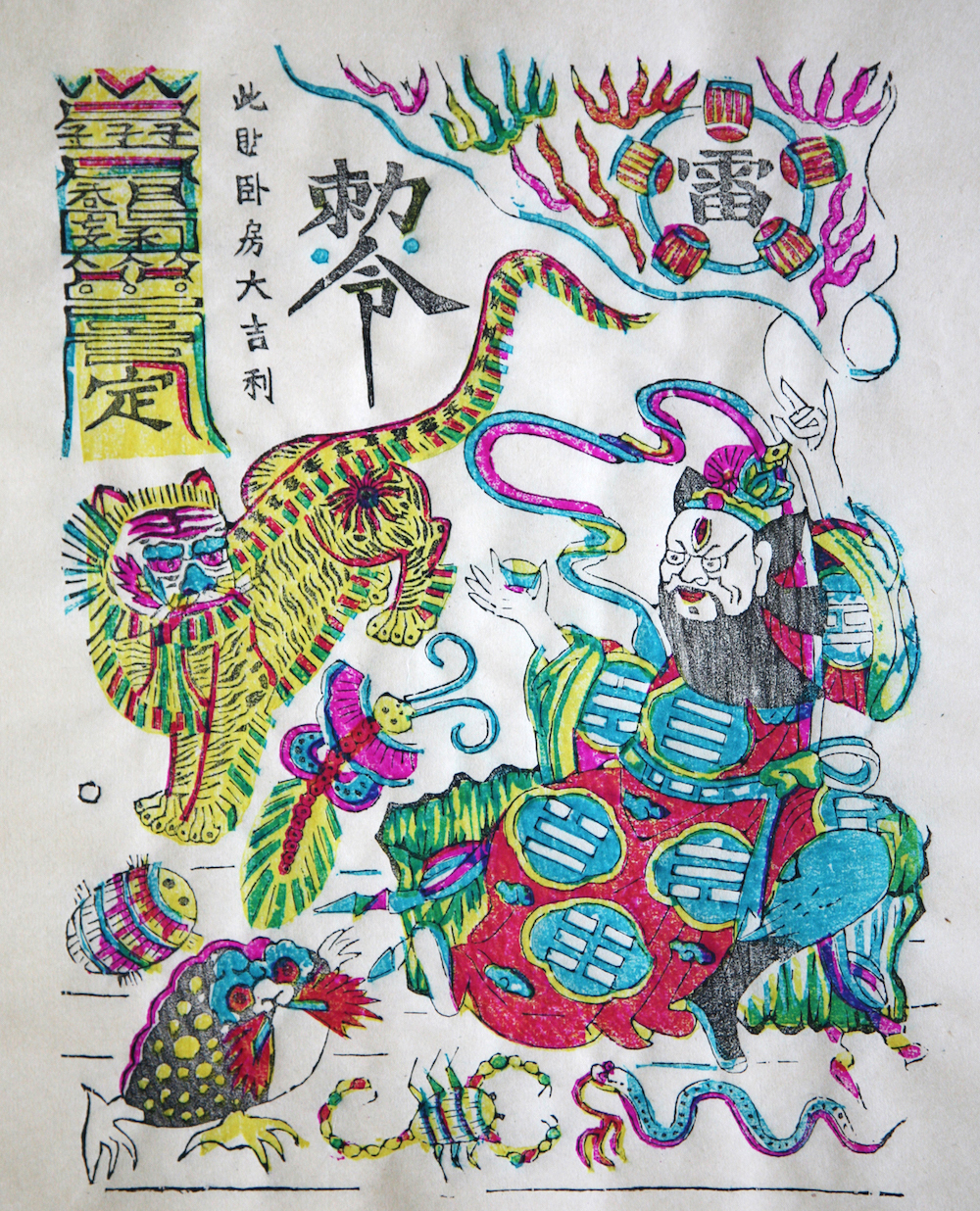
Zhang Tianshi downing the five poisons Shaanxi Fengxiang Tai Liping
"Zhang Tianshi Conquering the Five Poisons", also known as "Five Thunder Talismans", depicts Zhang Tianshi, the founder of Wudou Rice Dao in the Eastern Han Dynasty. In Song Liu Songnian's "Planting and Weaving Picture", there is a picture of a celestial master's practice on the beam of a farmhouse. It is learned that the image of Tianshi was very popular in the Song Dynasty. In this picture, Zhang Tianshi sits on a rock and wears a gossip costume. He raises his hands to sacrifice the five thunder talismans to eliminate poisonous insects such as snakes, scorpions, toads, and centipedes.
Lei Gong subdues the five poisons, Fengxiang, Shaanxi Province, Shaanxi Qunyi Museum
Another image of Lei Gong who expels the five poisons appeared in "Lei Gong Conquering the Five Poisons". The Lei Gong depicted in the painting basically matches the Lei Gong recorded in Huang Feiran's "Ji Shuo Chuan Zhen" in the late Qing Dynasty, that is, "like a warrior with a naked chest and frankness" The abdomen, the back with two wings, the forehead with three eyes, the face as red as a monkey, the lower jaw is long and sharp, the foot is like an eagle, and the claws are stronger. The ring hangs with five drums in a row, and the left foot crouches for a drum, called Lei Gong Jiang Tianjun" , the "five poisons" at the bottom of the screen see Lei Gong and flee in all directions. Among them, snakes and scorpions have been anthropomorphized into human head insects, and their faces are terrified. The shape of the whole New Year picture is vividly outlined. Most of Gu Yu's paintings, such as boys, have the meaning of protecting children and protecting them.
A boy riding a lion by Fengxiang Tai Liping, Shaanxi
The boy on the screen of "Boy Riding a Lion" rides a green lion, holding a flag in one hand and a gun in the other, and is majestic. The inscription on the forehead of the painting reads: "In the Grain Rain in March, the lions descended to the Heavenly Palace. They did not eat human food, but the five poisonous essences . The lion is the king of beasts, fierce and majestic, and people think that it can expel poison and eliminate disasters. This kind of painting of a boy riding a lion and descending the five poisonous essences was usually pasted on the wall of the house in the old days, expressing prayer for peace and harmony. In another "Fat Baby Playing the Three Strings", the boy has three peach black hair on his head, wears a brocade-trimmed begonia flower dress, flower trousers, wears a light blue shoe, sits cross-legged on one knee, and holds a three-stringed musical instrument in his arms. , pressing the strings with the left hand and plucking with the right hand. The sound of the strings is really moving. In addition to the inscription, there are also engraved inscriptions: "I serve the Taishang Laojun in a hurry as a law" and a spell. Folk artists create Gu Yu paintings with children's themes. After the Grain Rain, the weather turns hot and snakes, scorpions and other reptiles go out. Children are ignorant and often hurt. Therefore, everyone is reminded to pay attention to safety and not be bitten by insects.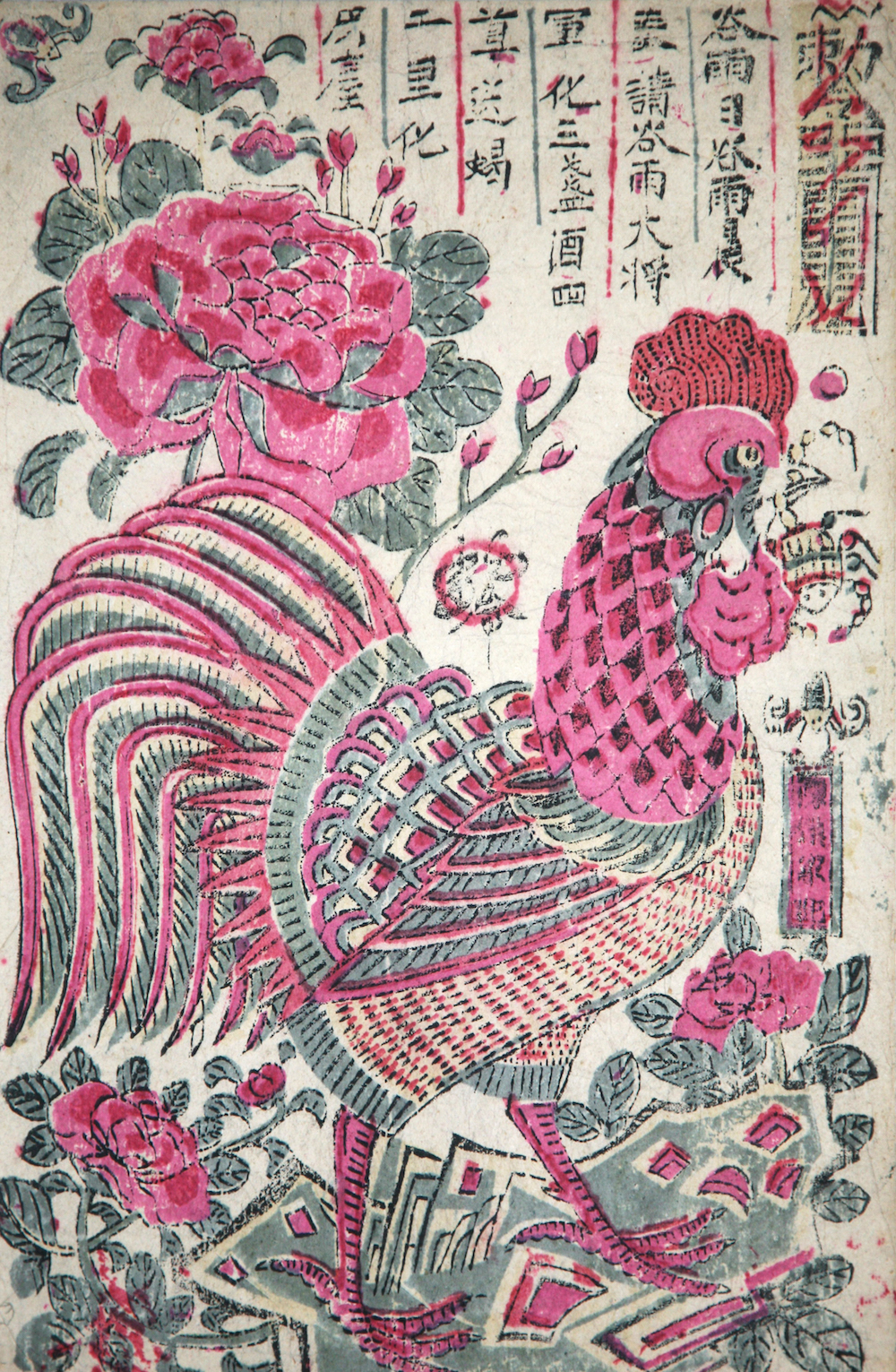
Daji Dali Shaanxi Provincial Culture Collection
The animal figures most depicted in Fengxiang Guyu's paintings are chickens and scorpions. There is a folk saying in Guanzhong that "dog bites stupidly, scorpion hooks disaster", it is believed that scorpion will make people sick, and it is an ominous thing, but chickens are regarded as "grain rain general" by local people because they are good at eating scorpions. Different from the double chicken, it mainly takes the shape of its beak pecking a poisonous scorpion to ensure the safety and health of the family. Among them, "Great Fortune" depicts a big red-crowned rooster with a poisonous scorpion in its beak. The upper right has a talisman that reads , "Gu Yuri, Gu Yuchen, please invite General Gu Yu. Three cups of tea, four cups of wine, and a scorpion. Thousands of miles turn into dust" , the top left and bottom of the picture are painted with peony, because the peony blooms during the Grain Rain, so it is called "Grain Rain Flower", and the peony has the meaning of wealth and honor, and the chicken is homophonic "Ji", the two are painted in one Drawing on the auspicious meaning of wealth and auspiciousness.
Single Chicken Shaanxi Fengxiang Tai Liping
The same pattern is also commonly known as the "Single Chicken" New Year painting. The main pattern in the painting is a chicken and a peony flower, but the text above is changed to "The scorpion is poisonous by nature. It is impossible to escape in an instant. I am in a hurry as ordered by Taishang Laojun."
Chicken Eating Five Poisons Collection of Shaanxi Provincial Cultural Museum
In addition, "Chicken Eats Five Poisons" depicts a scene where a hen leads a group of chickens to eat scorpions before and after the Grain Rain. The hen lies in the center of the picture, and the chickens surround it. Holding a nest and feeding a nest, this nest is more than that nest; when a scorpion pecks, a group of chickens will satisfy their hunger and thirst.” There are peony flowers that symbolize wealth and honor, and the whole picture is meant to avoid evil and seek good luck. "Double Chickens" depicts a boy and a girl wearing belly pockets and riding on the back of a rooster, holding banners "Blessings from Heavenly Officials" and "Auspicious Celebrations". Each rooster pecks a poisonous scorpion, and in the middle is engraved with the "Edict of Thor" charm, which reads "The golden rooster in the sky croaks, and the jade rooster in the ground croaks again." This painting is also sold in the Gansu area, and it is also a "talisman painting" that people stick on the door wall to prevent poisonous insects from harming children.The images of "Shen Judgment" in Fengxiang Guyu's paintings are quite diverse, and the folk names are different. Menjuan is a collective name for the evil spirits of chasing ghosts and towns in folk New Year paintings, mostly Zhongkui, Tianshi and the like. "Judgment" means judgment and distinction. In ancient times, there was a "judgment" in the official system. It was the line of the local governor, handling official affairs and deciding lawsuits. According to local folklore, the son is the official in charge of the ghosts of the "underworld" and the good and evil in the world. Some people also call the sentence "official", which means the official who is in charge of the wealth, the poor and the poor in the next life. In addition, there is a "Dance Judgment" in the "Hundred Operas" recorded in "Tokyo Dream Hualu", "A cane exploded, a man with a long beard and a mask, showing a green robe and boots, like the image of Zhong Kui, and a person beside him greeted each other with a small gong. The dance steps are called 'dance judges'". "On the day of extermination, there will be a large Nuo ceremony in the ban... Jiaofang Nan He Tan is ugly and fat, pretending to be a judge, and also pretending to be Zhong Kui, Xiaomei, land, kitchen god, etc., a total of more than 1,000 people..." It can be seen that in the Northern Song Dynasty Such an image already exists.
The door judgments in Fengxiang Guyu's paintings are roughly divided into "Riding Door Judgment", "Double Door Judgment", "Shenzhen Judgment in Town House" and "Lingbao God Judgment". The characters in "Riding in the Door" are fierce and mighty. They wear a pheasant-ling helmet across the horse, a large knife in one hand, and a pheasant's ling on the other. Deterrent. It is said that this character is modeled as Gai Suwen. Gai Suwen, also known as Yuan, changed his name because he avoided Li Yuan, the emperor of the Tang Dynasty. "New Book of Tang Biography" records that Gai Suwen's "nature is violent. . . . . . . Raise the horse." Folks stick it on the door as a door god, believing that its mighty and ferocious image will block ghosts. Another said that the two men were Ma Wu and Yao Qi of the Eastern Han Dynasty. The local people in Fengxiang call a pair of New Year pictures with the image of the Hu people as "Double Door Judgment", but judging from their characters, it seems that it should be called "Huihui Jinbao". Such New Year pictures are rarely seen in New Year pictures from other origins in the country. , or because Shaanxi is close to the northwest, there are many such forms. There is a saying in the folks that "return to treasure", generally based on the image of people from the Western Regions, to depict the treasure god of wealth, this theme is mostly used in New Year pictures, stone carvings and other folk art forms. On the screen of "Double Door Judgment", the Hu people have high noses and deep eyes, short beards, wrinkled faces, smiling smiles, and beaming joy. The two held a cash cow and the treasures of the ethnic minorities, swords and weapons behind them, ochre red and dark green boat-shaped mustaches on their heads, short jackets, robes, and boat-shaped shoes. The whole New Year picture pays attention to the use of lines, whether it is the short lines depicting the beard and hair or the long lines that outline the characters' bodies and clothing, they are all handled just right. The late Fengxiang New Year painting successor Tai Yi wrote this New Year painting to be included in the Gu Yu painting, but from the analysis of the shape and form of the two pairs of works, it seems that it is more like the door judgment used in the New Year, rather than the Gu Yu, which needs further research. confirm.

The Judgment of the Town House-1 Shaanxi Fengxiang Tai Liping

The Judgment of the Town House-2 Shaanxi Fengxiang Tai Liping
"Zhen Zhai Divine Judgment" is also known as "Cinnabar Judgment" or "Cinnabar God Judgment" in Fengxiang. Zhen Zhai Shen Judgment This pair of pages has been widely circulated in Shaanxi, Gansu, Ning, Sichuan, Henan and other places since the mid-Qing Dynasty. In this pair of New Year pictures, the judge's head wears a judge's hat, and he wears a broad robe. He holds a sword in one hand, and strokes his beard in the other. There are five bats around him, which means "blessing is in front of you" and "hate that blessings come late." The robes move with the wind. Make the picture full of tension and movement.
Lingbao Divine Judgment-1 Shaanxi Fengxiang Tai Liping
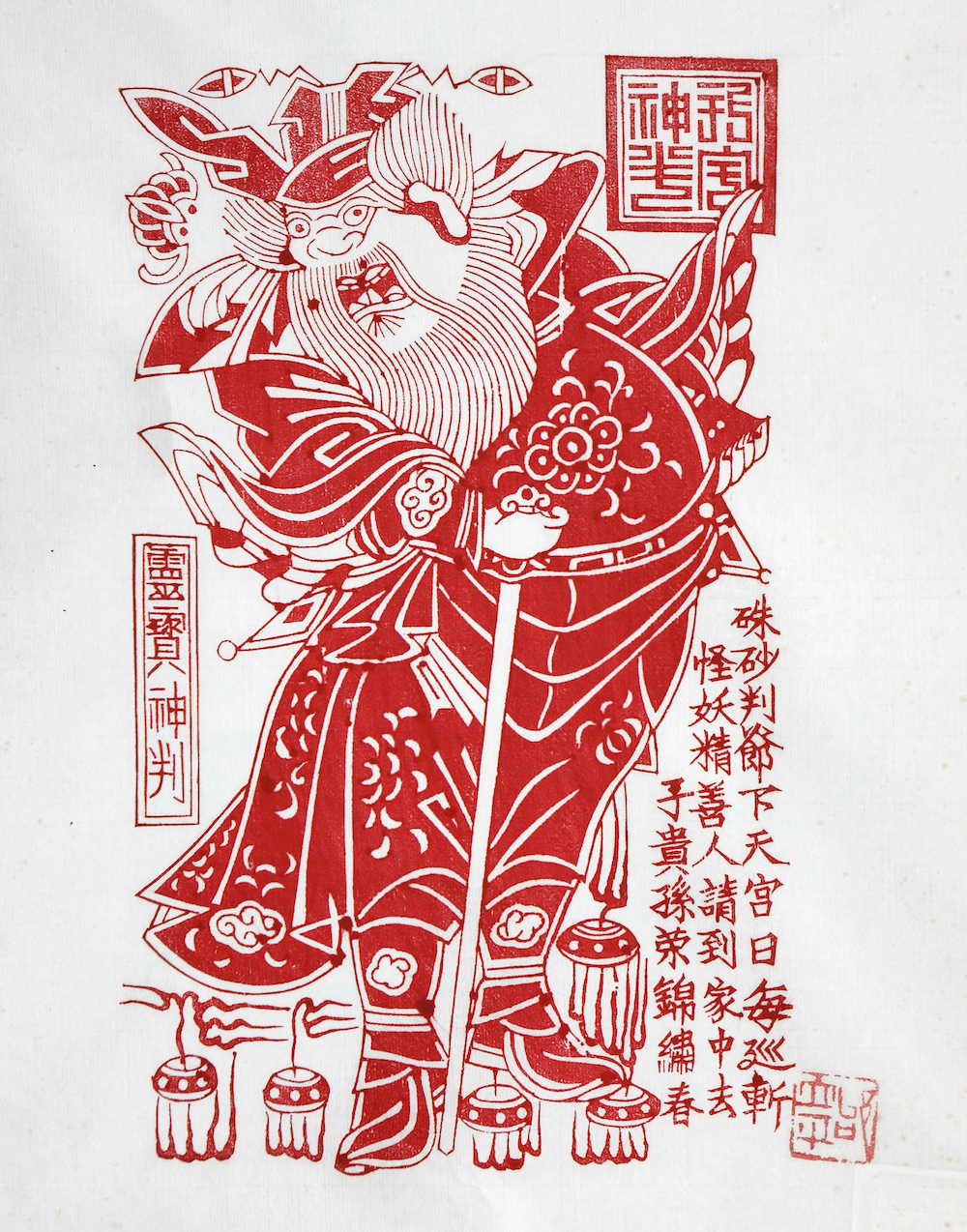
Lingbao Divine Judgment-2 Shaanxi Fengxiang Tai Liping
The other pair of "Ling Bao Shen Judgment", also printed in cinnabar, wears a judge's hat, holds a sword, wide eyes with anger, and a bloody mouth, which is daunting. There is a bat flying in each corner of the upper corner, and the picture is engraved with two Fang Dayin, with the inner book "Shenzhen Judgment", makes the composition of the picture full, and has the meaning of protecting the home and praying for the safety and well-being of the family. According to Fengxiang's local statement, these two paintings were pasted on the back door of the house.The Artistic Characteristics and Cultural Connotation of Guyu Painting
As a kind of Fengxiang woodblock New Year pictures, Guyu Painting has always been based in the urban and rural areas of Guanzhong. Its creators are all from folk painters or artists, and the consumer groups are mainly the general public in the northwest, so it has formed its robust and heavy overall style. The purpose and concept of Gu Yu Painting’s creation always follow the principle of pursuing auspiciousness and happiness, seeking good fortune and avoiding harm. When it is reflected in the picture, it requires full composition, large color blocks, conspicuous tones, and thick and powerful lines. The lines and brushstrokes are very close to the drawing style of the local temple murals; while most of the scenes reflecting the labor process and solar terms of folk farming are more realistic, for example, the characters in "Ten Busy Men" and "Ten Busy Women" resemble ordinary men and women. , and each painting is composed of many people, the pictures are full and rich, and the layout and order are reasonable, which is in line with the folk psychology of seeking perfection.
Words are an important part of Guyu's paintings. In Fengxiang's Guyu paintings, there are many compositional methods that use easy-to-understand poetic language to point out the subject of the picture. Almost two-thirds of Gu Yu's paintings are accompanied by text, and the pictures are accompanied by text and text to make the picture more full. The text accompanying the pictures is catchy and rhymed in the local dialect. On the one hand, these words play a role in explaining the picture, and on the other hand, they are also important materials for the study of rural social life and local folk formulas and songs in the northwest region. For example, although the work "Chicken Eats Five Poisons" uses a vigorous rooster as the main body of the picture, it is accompanied by inscriptions and incantations, and the purpose of the picture is pointed out in straightforward language, which also makes the composition of the picture more full. In addition, "Little Figure" and other works are supplemented with some text in the blank space to describe the content of the picture clearly, and the combination of pictures and texts plays a certain role in education and aesthetic education.
In addition, Nanxoli Village, where Guyu paintings are produced, is inconvenient in transportation, and is rarely affected and influenced by external art trends.
Different from the well-known New Year pictures, which were put on the market and posted before the Spring Festival, Gu Yu paintings were sold and used during the period after the Spring Festival and before the Grain Rain. In addition to the Spring Festival, you can also appreciate New Year pictures and beautify the environment. Guyu painting is a New Year painting created according to the solar term, so it is closely related to local folk customs and reflects rich folk customs. For example, in Gu Yu's paintings "Ten Busy Men" and "Ten Busy Women", which express the characteristics of farming society, the farming tools and textile tools in the pictures are important materials for studying the historical evolution of hand tools in the agricultural society. The content related to the four solar terms also has the function of reminding farmers not to make mistakes in farming and to arrange their daily life reasonably.
In addition, Gu Yu painting relatively completely inherits the traditional theme of New Year pictures and the unique symbolic and allegorical decoration techniques of folk art, forming a unique artistic language, which has the value of studying folk culture. For example, most of the animals in Gu Yu’s paintings are chickens. From a natural and objective level, chickens are good at pecking insects and scorpions, but in terms of spiritual connotation, this is still derived from people’s worship of animal totems. Liang Zongmao's "Jingchu Sui Shiji" records: "On the first day of the first month, a chicken house is pasted, a reed rope is hung on it, a peach is placed next to it, and hundreds of ghosts are afraid of it." It can be seen that the chicken itself has the "hundred" The folk attributes of "fear of ghosts", and chicken and "auspicious" are the same sound, which is in line with people's psychology of sticking and using grain rain paintings to exorcise evil spirits and avoid disasters, and welcome auspiciousness and good fortune. In addition, when matching plants, Gu Yu paintings are often decorated with auspicious flower patterns such as peony to express people's expectations for wealth and a better life. Guyu painting serves people's production and life, and people rely on Guyu painting to seek spiritual happiness, place good wishes and increase their confidence in life.
These Gu Yu paintings with folk-custom connotations are not only a colorful embellishment in folk custom and solar terms, but also have the aesthetic connotation of folk art. They have become cultural carriers for people to increase their knowledge, enhance aesthetic education, and inherit their beliefs. It is an important resource for the study of Shaanxi folk customs. The unique cultural schema, rich themes and contents of Guyu Painting, as well as the folk custom functions it reflects, also directly adapt to the needs of the people's spiritual and material life, and are a true portrayal of the solar terms and folk customs in the Guanzhong area of Shaanxi Province.
The author of this article is the China National Academy of Arts.